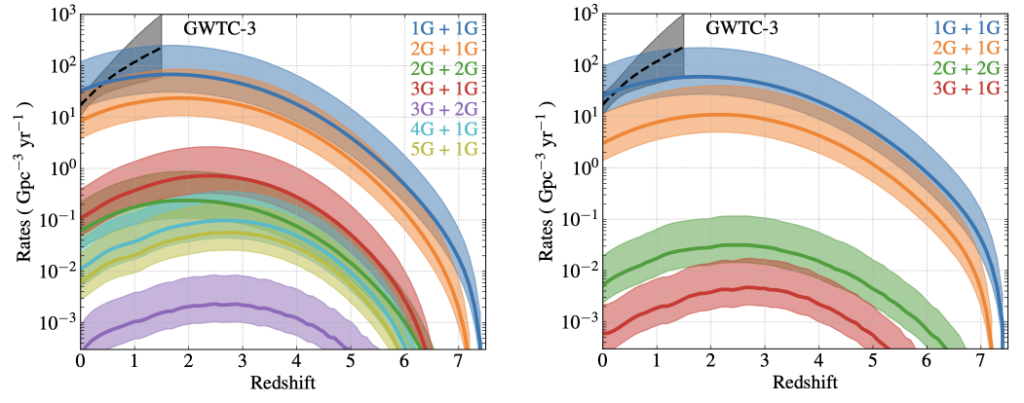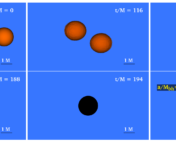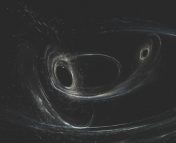Title: Demographics of Hierarchical Black Hole Mergers in Dense Star Clusters
Authors: Giacomo Fragione, Frederic A. Rasio
First Author’s Institution: Department of Physics & Astronomy and Center for Interdisciplinary Exploration & Research in Astrophysics (CIERA), Northwestern University, USA
Status: open access on the arXiv
Observations of gravitational waves from binary black hole (BH) mergers with the LIGO/Virgo/KAGRA (LVK) collaboration have revolutionized our understanding of the demographics of compact objects (such as neutron stars and black holes). At the range detectable by these instruments, for example, they have shed light on the distribution of BH masses, which gives us a glimpse into the late-stage evolution of massive stars. In particular, stellar evolution models predict a dearth of black hole remnants with masses between fifty to a few hundred times the mass of our Sun, because of the so-called pair-instability process. However, LVK observations have indicated the presence of black hole binaries where one is in this pair-instability range, meaning that the simple stellar evolution picture doesn’t fully explain the observed population!

Systems of binary black holes are believed to form by two main channels: in isolation from a binary star system and dynamically, as depicted in Figure 1. In the former (left), the binary system evolves through a common envelope phase, which, if the conditions are right, will result in a system of binary BHs. In the dynamical pathway (right), interactions between stars in the dense centers of clusters are frequent and can lead to the formation of binary BH systems. Subsequent interactions can tighten the orbit, leading to mergers.
Focusing on the latter channel, today’s authors explore how such a mechanism could produce intermediate mass black holes (IMBHs; BHs with masses between 100-1000 solar masses, i.e., the ones that we were missing from stellar evolution alone!), specifically in the form of hierarchical BH mergers. Hierarchical BH mergers are those in which one (or both) of the component BHs is a so-called ‘later generation’ BH: the remnant of a previous binary BH merger in the center of a dense star cluster (so a first generation BH is one produced at the end of a star’s life, a second generation one is formed from two previous BHs, and so on). These sorts of repeated mergers of stellar mass BH remnants would yield BHs in the IMBH range, providing a natural answer to the provenance of these BHs. Today’s authors utilize a new modeling framework to predict the properties of star clusters that can produce a detectable distribution of hierarchical BH mergers.
Demographics of Cluster Hosts
The primary challenge associated with this channel of IMBH formation is the ‘recoil kick’ that results from asymmetry in the merger process. In some cases, the velocity with which the resulting BH forms can exceed the escape velocity of the star cluster in which it formed, leading to ejection (and thus limiting the possibility of a subsequent, hierarchical merger). Using the modeling framework developed in a previous work, today’s authors are able to predict the properties of clusters that will be able to retain a binary BH remnant after the merger, as displayed in Figure 2. From these panels it is clear that hierarchical BHs are likely only produced and retained in the most massive and densest clusters, as these will be the ones with the deepest potential wells and highest rates of interaction.

In these massive and dense clusters, repeated BH mergers can eventually result in the formation of a single massive black hole >1000 times the mass of our Sun which dominates the interactions and binary merger process. It turns out that these massive BHs generally grow as a result of mergers with first-generation BHs, as mergers of two hierarchically-produced black holes (i.e., two second- or third-generation BHs) tend to impart a strong kick on the remnant, driving it to escape from the cluster. Therefore, robustly modeling the effect of kicks is crucial to understanding the rates of IMBH formation by this hierarchical merger process.
Merger Rates and Assorted Sundries
With their framework in hand and the properties of the cluster hosts understood, today’s authors then average over the distribution of star clusters of different masses as a function of time to predict merger rates of various generations of hierarchical BHs. In Figure 3, the authors demonstrate that massive clusters (with masses up to 107 solar masses) are necessary to produce later generations of BH mergers. That is, they find that the rates of hierarchical BH mergers fall as the maximum cluster mass is lowered from 10 million to 1 million solar masses, as the lower mass clusters are less likely to hold onto the resulting BHs. In kind, the merger rates for component BHs later than third-generation disappear.

Relatedly, they compare the distribution of merging BH masses detected with the LVK observatories to those predicted by their model. From such analysis, they demonstrate that, within their framework, several of the observed events can only be produced by accounting for hierarchical BH mergers, with a few appearing to come from mergers of second- and third-generation BHs!
These results, while preliminary, can be extended (by incorporating other metrics, such as the BH spins) to statistically measure the likelihood of individual gravitational wave events being associated with hierarchical mergers. However, they represent an exciting step towards understanding where these intermediate mass BHs come from and provide a compelling, natural explanation for how a large population of massive BHs can form and continue to evolve over cosmic time!
Astrobite edited by Mark Popinchalk
Featured image credit: adapted from Surprising_Shots




